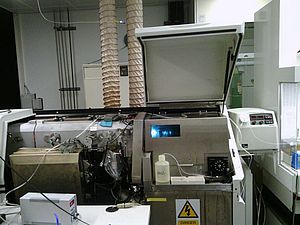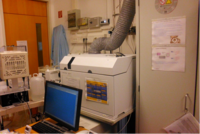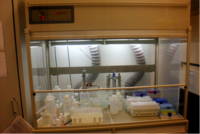Head of the research unit
Prof. Dr. Anton Eisenhauer
Contact person for this topic
Ana Kolevica
Dr. Jan Fietzke
Dr. Volker Liebetrau
Personal Assitant / Office Management:
Christine Utecht
The Finnigan Triton TI (Thermo Scientific) is a thermal ionization mass spectrometer. It is used to measure isotope ratios of the stable and radiogenic isotopes of strontium, calcium, neodymium, uranium, and boron.
Installed at begin of year 2002 this double-focusing ICP-MS (Inductively Coupled Plasma Mass Spectrometer) is equipped with 10 Faraday Cups (9 moveable) and a Multi-Ion-Counting (MIC) unit consisting of 3 channeltron SEM. The instrumentation provides fully adjustable resolution (300-10000 RES) and a dynamic range of 9 orders of magnitude. The high core temperature of the Argon plasma (~6000 K) allows for an efficient ionization of most elements of the periodic table. Both, liquid and solid samples are determined for their isotopic composition using either conventional nebulization plus desolvation (CETAC ARIDUS or ESI APEX) or alternatively the Laser Ablation unit (ESI NWR UP193fx) (link to Facilities_5)
Recently the applications focus on U-series, Sr and B isotopes used for dating fossil carbonates (U/Th), SIS and provenance studies and pH reconstructions. Besides these the instrument has been used for Ca, Mg, Hf, Nd, Pb, Cl, Pa, Ra isotope studies. Due to its flexibility the instrument contributes to all four topics of "Marine Isotope Geochemistry".

The ICP-MS-Quadrupole Agilent 7500cx is running in our Lab since end of 2010. It is equipped with two lens-stucks. The ce-lens-stuck is used for a stable run of high matrix samples. The cs-lens-stuck provides high sensitivity allowing the measurement of traces in low-matrix-samples. The collision and reaction cell is very effective in removing polyatomic interferences. It works with Helium and Hydrogen. For the sample introduction, depending on the matrix, it is possible to use self-aspirating nebulizers (as the100µl PFA-micro-flow) or the peristaltic pump in combination with a nebulizer (as the 200µl micromist-sea-water).
In our lab the Agilent 7500cx is used for the precise measurement of
The lab is furnished with clean air through air filters type H14. The air pressure in the room is hold slightly higher than the normal to avoid contaminations.
For sample dilutions and preparations a laminar-flow-box is installed in the lab.



The lab for short-lived isotopes is temperature stabilized and provides two ship-going LSC (Liquid Scintillation Counter) systems with alpha/beta separation. One compact fully mobile single-sample device (Triathler, Hidex) and a semi-mobile auto-sampler based (Guardian, Wallac/PerkinElmer) system, plus preparation line for water and pore water samples, mainly used for Radon analyses of advective marine fluid systems. The lab provides a switchable (over/under pressure) H14-filter clean air laminar flow box for chemical preparation routine and hosts the upcoming shared 210Pb alpha-counting facility (CAU (University Kiel) / Excellence Cluster / GEOMAR), including vacuum assisted plating based alpha-counter and microwave sample digestion system.

